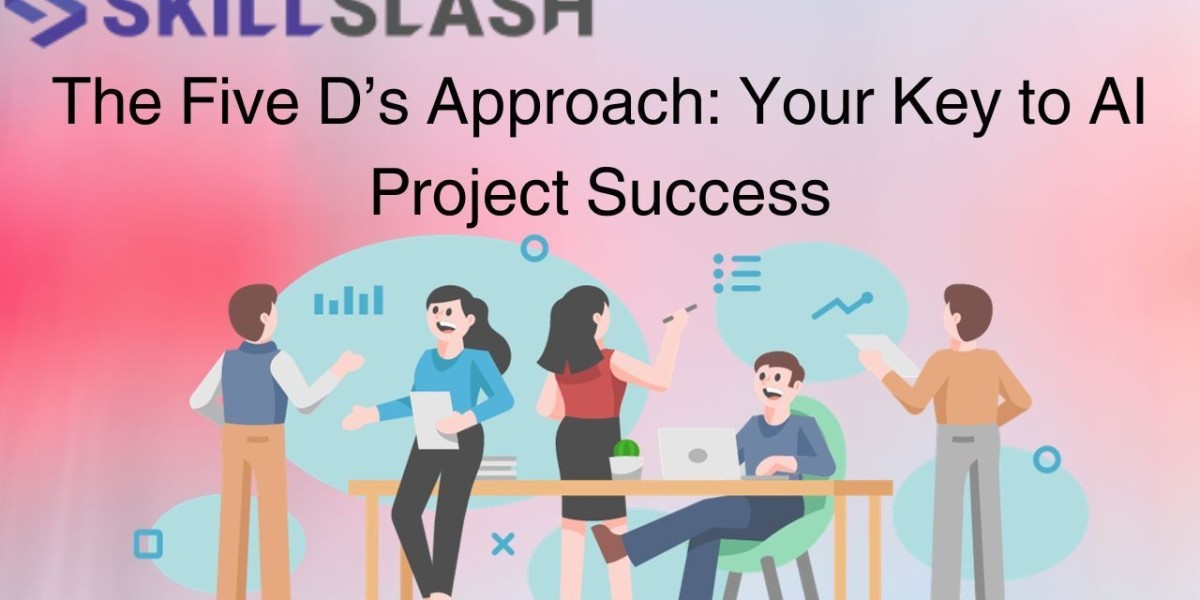Artificial intelligence (AI) is a game-changer in the ever-changing world of technology, and it has the potential to revolutionize almost every industry. But harnessing the power of AI is not that easy. A lot of companies jump into AI projects with big dreams, only to face huge obstacles and challenges. To stay ahead of the game and make sure your AI projects are successful, you need a well-thought out and strategic approach.
Here, enters the application of the “Five Ds approach” - a framework that’s become a go-to guide for organizations looking to get the most out of AI.
Read on to find out what the “Five Ds Approach” is all about, its principles, and how it can help you succeed in an AI-driven future. Whether you’re an experienced pro at AI or just starting out, we have got you covered with a tried and true methodology that can help you take your AI projects to the next level.
The Five Ds Approach is a problem-solving framework that provides a structured way to approach and address challenges or tasks. Each of the five Ds represents a distinct step in the process.
Let’s look into each of the D’s in detail and understand them below:
Define
In the Five Ds Approach, the “Define” stage is all about clearly understanding and articulating the problem or task you’re facing.
This step involves:
Identify the Problem: Begin by identifying the problem or challenge that needs to be addressed. Be as precise as possible. Identify the symptoms or signs of the problem.
Set Objectives: Set goals for what you hope to accomplish by solving the problem or completing the task. Your goals should be measurable and pertinent to the problem.
Gather Information: Collect pertinent data and information related to the problem. You can do this by conducting research, conducting data analysis, conducting interviews, or by any other means that will help you gain a better understanding of the issue.
Define Limits: Define any limitations or restrictions that will affect your approach and solution. This could be a budget constraint, time constraint, resource constraints, or other factors that must be taken into account.
Identify Key Stakeholders: Identify key stakeholders who are involved in the problem or affected by it. Get an idea of what their perspectives are, what their interests are, and what their concerns are. This way, you can avoid conflicts and make sure that your solution meets the needs of everyone involved.
Problem Statement: A problem statement is a summary of the problem and its objectives. It should be concise and concise. It will serve as a point of reference throughout the problem
By thoroughly defining the problem and your objectives in the “Define” stage, you lay the foundation for the rest of the Five DS Approach.
Design
Design is one of the most important stages of any AI project. It involves making important decisions about how to build, train, and deploy the AI system. Here are some of the key aspects of Design:
AI Model Selection: In this step, you determine which AI techniques, algorithms, and models are best suited to solving your specific problem. The choice of model depends on factors such as the type of data you have, the complexity of the problem, and the desired outcomes. For example, you might choose a deep neural network for image recognition tasks or a decision tree for a simpler classification problem.
Data Preprocessing: Before feeding data into the AI model, it's essential to preprocess the data. This includes tasks like data cleaning, data normalization, and feature engineering. Data preprocessing ensures that the data is in a suitable format for the AI model and can improve model performance.
Model Training: During this stage, you feed the prepared data into the chosen AI model and train it. This involves setting hyperparameters, selecting a training algorithm, and iterating on the training process to optimize the model's performance. It's a critical step where the model learns from the data.
Infrastructure and Tools: Design the technical infrastructure required for model development and deployment. This includes selecting the appropriate hardware and software resources, cloud services, and development tools. Consider scalability and performance requirements to ensure that the infrastructure can support the AI system's needs.
The design stage is the starting point for building and deploying an AI solution. By taking these design principles into account and making smart decisions, you’ll increase your chances of meeting your project goals and creating a strong and successful AI solution.
Develop
The “Develop” stage is the third “D” in the “Five Ds Approach” to AI project success. It’s an essential step in the AI project life cycle, where the design and plans of the previous stages are implemented. Here’s a detailed explanation of the processes involved in this stage:
Model Implementation: In the development phase, you start building the AI model that was designed in the previous phase. This involves writing code to implement the chosen machine learning or deep learning algorithms. Depending on the complexity of the project, this could involve programming in languages like Python, R, or using specialized AI development platforms and libraries.
Testing and Validation: Rigorously test the developed AI model to ensure it behaves as expected. Use a separate validation dataset that the model hasn't seen during training to assess its generalization performance. This phase helps identify and address issues like overfitting or underfitting.
Quality Assurance: Implement quality assurance processes to catch and rectify any errors or bugs in the AI model's code. These checks help ensure the model operates reliably and produces accurate results.
Interpretability and Explainability: Consider how the model's predictions or decisions will be interpreted and explained. Depending on the application, you may need to provide explanations for why the model made a particular prediction. This is particularly important in fields like healthcare, finance, and law.
Documentation: Properly document the development process, including code, algorithms, parameters, and configurations. Documentation is essential for future reference, troubleshooting, and knowledge sharing within the project team and across the organization.
The “Develop” stage is when the AI project really starts to come together, with the AI model and the software components being built. It’s important to stick to the best practices, make sure quality standards are followed, and work together to make sure the AI system works properly in real life.
Deploy
The “Deploy” stage of an AI project is important because it takes the model or system that was created in the previous stages and turns it into something that can be used in the real world. Here are some of the key things to keep in mind when you’re in this phase:
Integration: Ensure seamless integration of the AI model or system into the existing infrastructure or workflow. This may involve connecting it with databases, APIs, user interfaces, or other software components. Integration should be done in a way that minimizes disruptions to the organization's operations.
Scalability: Assess the scalability requirements of your AI solution. Consider whether it can handle increased usage and data volume as the system is adopted more widely. Ensure that the deployment architecture is designed to scale efficiently.
Testing in Production: Even after thorough testing during the development phase, it's essential to conduct testing in the production environment. Monitor the AI model's performance, accuracy, and response times under real-world conditions. Address any issues that arise promptly.
Monitoring and Maintenance: Establish a monitoring system for the deployed AI system. Continuously track its performance, including metrics like accuracy, latency, and resource utilization. Implement automated alerts to detect anomalies or issues in real-time. Regularly maintain the system by applying updates, patches, and security fixes.
User Training and Support: Provide training and support for end-users who will interact with the AI system. Ensure that they understand how to use it effectively and can troubleshoot common issues.
At the “Deploy” stage, an AI project goes from being in development to being used in the real world. It’s important to make sure it works well in production while still being secure, scalable, and easy to use. Keeping an eye on it and making sure it’s ethical is key to making sure it keeps meeting its goals.
Demand
This stage focuses on making AI accessible and usable by a broader audience within an organization. It involves the following key aspects:
Access and Accessibility: Ensure that the AI tools, models, and insights are accessible to a wide range of users, including non-technical stakeholders. This may involve creating user-friendly interfaces, dashboards, or APIs that allow users to interact with AI systems without needing deep technical expertise.
Collaboration: Encourage collaboration between different teams and departments within the organization. AI shouldn't be siloed in a specialized department; it should be integrated into various business functions to drive innovation and efficiency.
Feedback and Improvement: Establish feedback mechanisms to collect input and suggestions from users. Use this feedback to continuously improve AI solutions and address any usability or functionality issues.
Governance and Compliance: Implement governance policies and controls to ensure that AI is used responsibly and in compliance with relevant regulations and ethical guidelines. This includes monitoring and auditing AI systems for fairness, bias, and other ethical considerations.
Understanding the demand for AI enables organizations to get the most out of their AI investments by enabling a wider range of users to take advantage of AI capabilities, making data-informed decisions, driving innovation, and optimizing business processes.
In Conclusion, the “Five Ds Approach” is a great starting point for any organization embarking on an AI project. By taking data, design, development, deployment, democratization into account throughout the entire project lifecycle, companies can significantly improve their chances for success. Not only do successful AI projects meet their goals, but they also help drive innovation and organizational growth. As artificial intelligence continues to revolutionize industries, taking a holistic approach such as the five Ds approach is a strategic necessity to stay ahead of the curve and stay relevant in today’s rapidly changing artificial intelligence landscape.








